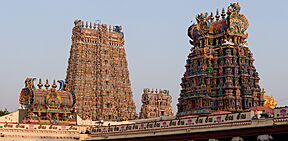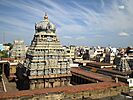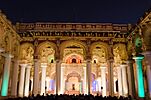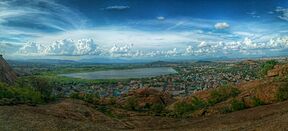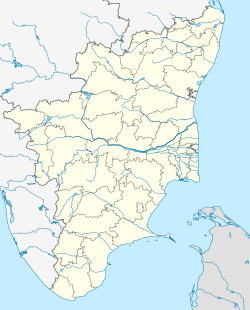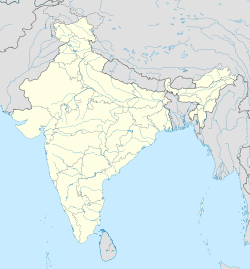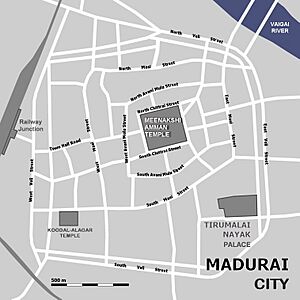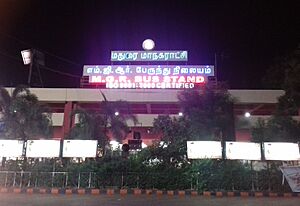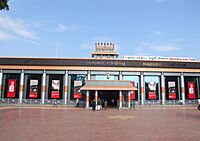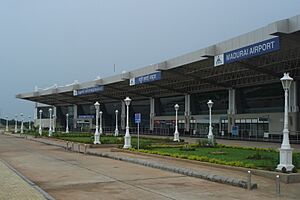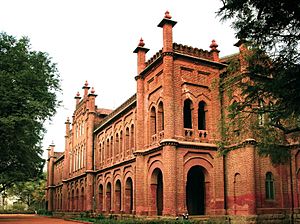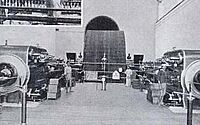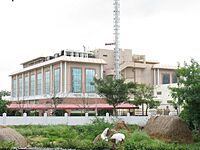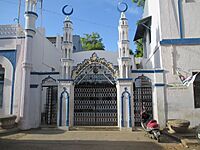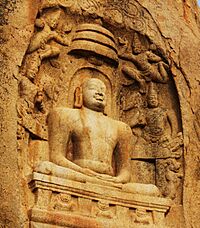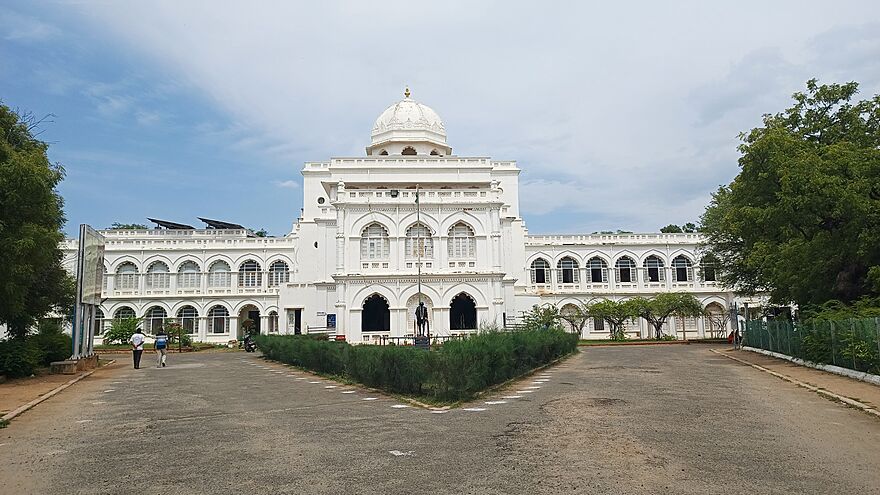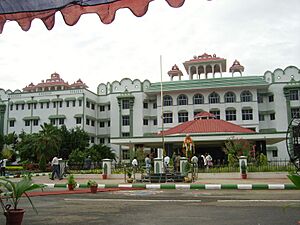Madurai facts for kids
Quick facts for kids
Madurai
Madura (colonial)
|
|
|---|---|
|
Meenakshi Sundaraswarar Temple
Koodal Azhagar temple
Thirumalai Nayakkar Mahal
Gandhi Museum
Madurai Junction
Madurai Airport
Thiruparankundram Aerial view
Madurai's famous landmarks
|
|
| Nickname(s):
Thoonga Nagaram (The City that never sleeps), Athens of the East, City of Jasmine, City of Festivals, Temple City
|
|
| Country | |
| State | |
| District | Madurai |
| Government | |
| • Body | Madurai Municipal Corporation |
| Area | |
| • Metropolis | 303.97 km2 (117.36 sq mi) |
| Area rank | 2 |
| Elevation | 134 m (440 ft) |
| Population
(2011)
|
|
| • Metropolis | 1,017,865 |
| • Rank | 44th |
| • Metro | 1,465,625 |
| • Metro rank | 31st |
| Language | |
| • Official | Tamil, English |
| Time zone | UTC+5:30 (IST) |
| PIN |
625 xxx
|
| Telephone code | 0452 |
Madurai is a big city in the Indian state of Tamil Nadu. It's known as the cultural heart of Tamil Nadu. Madurai is also called "Thoonga Nagaram," which means "the city that never sleeps." This is because it's always busy, even at night!
The city sits on the banks of the Vaigai river. Madurai has been a major place for over 2,000 years. Its history goes back more than 2,500 years. It's famous for its strong connection to the Tamil language. The third Tamil Sangam, a big meeting of Tamil scholars, is believed to have happened here.
Madurai is also an important place for industries and education in South Tamil Nadu. It has many factories that make things like car parts, rubber, chemicals, and granite. The city is home to important government colleges for medicine, law, and agriculture.
Contents
What's in a Name?
Madurai has many interesting names! One idea is that the name Madurai comes from an old Tamil word, matiray. This word means "walled city."
Another story says the area was once a forest of Kadamba trees. So, it was called Kadambavanam. The city is also known as "Koodal," "Malligai Maanagar," and "Thirualavai."
The name Koodal means a gathering of smart people. This refers to the three important Tamil Sangams (meetings of scholars) that took place in Madurai. "Naanmadakoodal" means "junction of four towers." This name points to the four big temples Madurai was famous for.
A Journey Through Time
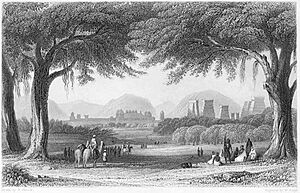
Madurai has been lived in for a very long time, at least since 300 BCE. Ancient writings from Greece and India mention the city. For example, Megasthenes, a Greek ambassador, might have visited Madurai.
The city's history includes many different rulers:
- The Pandya dynasty
- The Chola Empire
- The Madurai Sultanate
- The Vijayanagar Empire
- The Madurai Nayaks
- The British East India Company
After the Sangam age, the Kalabhra dynasty ruled Madurai. Then, the Pandyas took over around 590 CE. The Cholas later took control in the 9th century. Madurai was often fought over between the Cholas and Pandyas. In the 13th century, the second Pandyan empire made Madurai its capital again.
Later, the Delhi Sultanate ruled, followed by the Madurai Sultanate. The Vijayanagara Empire then took over. In 1559 CE, the Madurai Nayak Dynasty made Madurai independent.
In 1801, the British East India Company took direct control of Madurai. The city grew into an important political and industrial center. In 1837, the British removed the old walls around the temple. They used the materials to build new streets. Madurai became a municipality in 1866.
A very important event happened in Madurai in 1921. Mahatma Gandhi, a leader of India's independence movement, visited the city. He saw farmers wearing simple loincloths. This inspired him to adopt the loincloth as his own way of dressing.
In 1939, a law was passed that allowed all people to enter Hindu temples. This was a big step for equality. The movement to open temples started at the Meenakshi temple in Madurai.
In 1971, Madurai became a Municipal Corporation. This means it became a bigger, more important city with its own local government.
City Layout
Madurai is built around two main temples: the Koodal Azhagar temple and the Meenakshi Temple. These temples were the heart of the old city. The city has many streets that form circles around the temple.
Viswanatha Nayak, the first Nayak king of Madurai, planned the city's design. He followed old rules of architecture called Shilpa Shastras. The streets still have their traditional names, like Aadi and Masi streets. These names are also Tamil month names and are linked to festivals.
The temple's outer areas and streets are used for many festivals. During these events, large processions go around the shrines. The chariots used in these parades get bigger as they move further from the temple's center. Ancient writings say the city looks like a lotus flower with the temple as its center.
Weather and Nature
Madurai is located on a flat, fertile plain. The Vaigai river flows through the city, dividing it into two parts. To the north and west of Madurai are the Sirumalai and Nagamalai hills.
Most of the land around Madurai is used for farming. The Periyar Dam helps provide water for these farms. The main crop grown here is rice. Farmers also grow pulses, millet, oil seeds, cotton, and sugarcane.
Madurai has a hot, semi-dry climate. It's hot and dry for about eight months of the year. The hottest months are from March to July. From August to October, the weather is milder with heavy rains. From November to February, it's a bit cooler.
The average rainfall for Madurai is about 85.76 cm per year. Summer temperatures can reach around 42°C (107°F). Winter temperatures are usually between 18°C (64°F) and 29.6°C (85°F).
| Climate data for Madurai, India (1981-2010) | |||||||||||||
|---|---|---|---|---|---|---|---|---|---|---|---|---|---|
| Month | Jan | Feb | Mar | Apr | May | Jun | Jul | Aug | Sep | Oct | Nov | Dec | Year |
| Record high °C (°F) | 39.1 (102.4) |
38.5 (101.3) |
41.7 (107.1) |
42.1 (107.8) |
44.5 (112.1) |
42.2 (108.0) |
40.6 (105.1) |
41.7 (107.1) |
40.8 (105.4) |
40.0 (104.0) |
38.0 (100.4) |
37.0 (98.6) |
44.5 (112.1) |
| Mean daily maximum °C (°F) | 30.8 (87.4) |
33.3 (91.9) |
36.0 (96.8) |
37.2 (99.0) |
37.9 (100.2) |
37.2 (99.0) |
36.5 (97.7) |
36.2 (97.2) |
35.1 (95.2) |
33.1 (91.6) |
30.6 (87.1) |
30.0 (86.0) |
34.5 (94.1) |
| Mean daily minimum °C (°F) | 19.6 (67.3) |
21.5 (70.7) |
23.4 (74.1) |
25.6 (78.1) |
26.3 (79.3) |
26.2 (79.2) |
25.9 (78.6) |
25.5 (77.9) |
24.6 (76.3) |
23.7 (74.7) |
22.7 (72.9) |
21.3 (70.3) |
23.9 (75.0) |
| Record low °C (°F) | 15.6 (60.1) |
14.5 (58.1) |
16.9 (62.4) |
19.4 (66.9) |
17.8 (64.0) |
17.8 (64.0) |
19.4 (66.9) |
20.6 (69.1) |
18.5 (65.3) |
18.9 (66.0) |
17.2 (63.0) |
16.7 (62.1) |
14.5 (58.1) |
| Average precipitation mm (inches) | 8.5 (0.33) |
11.0 (0.43) |
18.3 (0.72) |
60.1 (2.37) |
80.6 (3.17) |
34.3 (1.35) |
56.9 (2.24) |
93.9 (3.70) |
121.5 (4.78) |
185.8 (7.31) |
147.2 (5.80) |
51.3 (2.02) |
569.4 (22.42) |
| Average precipitation days | 0.8 | 1.1 | 1.2 | 3.3 | 4.0 | 2.2 | 2.9 | 4.6 | 6.6 | 9.7 | 6.8 | 3.4 | 46.6 |
| Average relative humidity (%) | 77 | 77 | 76 | 72 | 70 | 68 | 70 | 71 | 71 | 76 | 78 | 78 | 74 |
| Average ultraviolet index | 7 | 7 | 8 | 8 | 8 | 8 | 8 | 8 | 7 | 7 | 6 | 6 | 7 |
| Source 1: Indian Meteorological Department Mean data from 1981–2010 | |||||||||||||
| Source 2: Weather Atlas | |||||||||||||
People and Languages
| Historical population | ||
|---|---|---|
| Year | Pop. | ±% |
| 1951 | 361,781 | — |
| 1961 | 424,810 | +17.4% |
| 1971 | 549,114 | +29.3% |
| 1981 | 820,891 | +49.5% |
| 1991 | 940,989 | +14.6% |
| 2001 | 928,869 | −1.3% |
| 2011 | 1,017,865 | +9.6% |
Source:
|
||
| Religion in Madurai (2011) | ||||
|---|---|---|---|---|
| Religion | Percent(%) | |||
| Hinduism | 85.83% | |||
| Islam | 8.54% | |||
| Christianity | 5.18% | |||
| Others | 0.47% | |||
In 2011, Madurai had a population of over 1 million people. For every 1,000 males, there were 999 females, which is a good balance.
Most people in Madurai are Hindus (85.83%). There are also many Muslims (8.54%) and Christians (5.18%).
The main language spoken in Madurai is Tamil. About 89% of the people speak Tamil. Another important language is Saurashtra, spoken by 5.4% of the population. Other languages include Telugu and Urdu.
Getting Around Madurai
Madurai has good connections to other cities. Several national highways pass through it. These roads connect Madurai to different parts of India. State highways also link various areas within the Madurai district.
The city has four main bus stands. These bus stands help people travel locally and to other cities. You can also find many auto rickshaws for getting around the city. There are also private mini-buses for local travel.
Madurai Junction is a very important railway station in South Tamil Nadu. You can catch direct trains from Madurai to major cities like Chennai, Coimbatore, and Kanyakumari. Madurai is connected by train to most important towns and cities across India.
Madurai International Airport is located about 12 kilometers from the city. It was first used by the Royal Air Force during World War II. The airport offers flights to some cities in India and international flights to places like Colombo, Dubai, and Singapore.
Learning and Education
Madurai has been a center for learning Tamil culture, literature, art, music, and dance for hundreds of years. The three famous assemblies of the Tamil language, called the Tamil Sangam, are said to have taken place in Madurai. Poets would share their works at these meetings.
The American College is the oldest college in Madurai, started in 1881. The Lady Doak College, opened in 1948, is the oldest college for women in the city. Other old colleges include Thiagarajar College, Madura College, and Fatima College.
Madurai Kamaraj University, started in 1966, is a state university. It has many colleges in Madurai and nearby areas. There are also several polytechnic schools and industrial training institutes.
Madurai has two government medical colleges and many engineering colleges. The Madurai Law College was established in 1979. An All India Institutes of Medical Sciences (AIIMS) hospital and medical college is also being built in Madurai.
Schools in Madurai
The city has a total of 369 schools. These include primary, secondary, and higher secondary schools.
- Capron Hall Higher Secondary School, Madurai
Madurai's Economy
In the past, Madurai was mostly an farming area. Rice was the main crop. Cotton farming was introduced in the 16th century to help increase income. Farmers also earn money from dairy farming, poultry, pottery, and carpentry.
Madurai is very famous for its jasmine flowers, known as Madurai Malli. These flowers are grown near the Kodaikanal hills and sold at the Madurai morning flower market. Thousands of farmers sell flowers there every day.
Since 1991, many Small Scale Industries (SSIs) have grown in Madurai. This has created more jobs. Madurai is one of the few places in South India where rubber is grown. There are many industries that make rubber products like gloves, sporting goods, and car parts.
The city also has many textile, granite, and chemical factories. Madurai is becoming a hub for IT and other industries. Big companies like HCLTech and Honeywell have offices in Madurai's IT Park.
Places of Worship
Madurai is known for its many beautiful temples and religious sites.
- Meenakshi Amman Temple is a very old and famous Hindu temple. It's dedicated to the goddess Meenakshi and her husband, Shiva. The temple has 14 tall towers called gopurams. The tallest one is about 51.9 meters (170 feet) high! This temple was built between 1623 and 1655 CE. It attracts thousands of visitors every day. There are an estimated 33,000 sculptures in the temple.
- Koodal Azhagar Temple is another historic Hindu temple in Madurai. It's dedicated to the god Vishnu. This temple is special because it has idols of the Navagraha (nine planet deities), which are usually found in Shiva temples.
- Kallalagar temple (Alagar Koyil) is a Vishnu temple located outside Madurai. The deity, Kallazhagar, is believed to be Meenakshi's brother. The festivals of these two temples often happen at the same time.
- Pazhamudircholai is one of the six holy homes of the Hindu god Murugan. It's located on the Solaimalai hill.
- Thiruparankundram is a hill near Madurai. It's believed that the Hindu god Murugan married Deivanai here. This temple is one of the most visited tourist spots in Madurai.
- Kazimar Big Mosque is the first Muslim place of worship in Madurai. It was built in the 13th century. The graves of important Islamic saints are located inside this mosque.
- Goripalayam Mosque is another mosque where the graves of three Islamic saints are found.
- St. Mary's Cathedral is a big Catholic church in Madurai.
- Samanar Malai and Panchapandavar Malai are important centers for the Jain religion.
Culture and Fun
Madurai is often called Thoonga Nagaram, the "city that never sleeps," because it's lively even at night. Many tourists from India and other countries visit Madurai.
- Thirumalai Nayak Palace is a beautiful palace built in 1636 CE. It's a national monument. You can watch a daily sound and light show there that tells the story of King Thirumalai.
- The palace of Rani Mangamma now houses one of the five Gandhi Memorial Museums in India. Martin Luther King Jr. visited this museum, and it inspired him to lead peaceful protests.
- Madurai has fun parks like the Eco park and Rajaji children park. The MGR Race Course Stadium is a sports stadium with a running track and swimming pool.
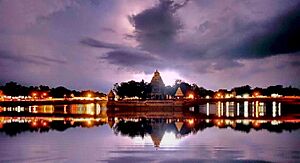
The people of Madurai celebrate many festivals:
- Meenakshi Tirukkalyanam (Chittirai Festival) is a 10-day festival in April–May. Over a million people visit for this event. It celebrates the wedding of Meenakshi and Sundareswarar.
- The Cradle festival is when the idols of Meenakshi and Sundareswarar are placed on a rocking swing for nine days.
- The Avanimoolam festival in September tells the stories of 64 sacred games of the Hindu god Shiva.
- The Thepporchavam festival (float festival) is in January–February. Decorated idols are floated on a raft in the Mariamman Teppakulam (temple tank).
Jallikattu is a very popular traditional sport in Tamil Nadu. It's part of the Pongal harvest festival in January. In this event, people try to tame bulls. It's a display of strength between humans and bulls.
Muslims in Madurai celebrate Santhanakoodu festivals to honor Islamic saints.
City Services
Madurai has several radio stations, including government and private channels. You can read English newspapers like The Hindu and The New Indian Express. There are also many popular Tamil newspapers like Dinamalar and Dina Thanthi.
The Tamil Nadu Electricity Board (TNEB) provides electricity to the city. The Madurai Municipal Corporation supplies water to homes. About 400 metric tonnes of waste are collected from the city every day.
Madurai has a good sewer system, which was first set up by the British in 1924. Most homes now have an underground drainage system.
The city also has a regional passport office. The Government Rajaji Hospital serves the city. A branch of All India Institutes of Medical Sciences (AIIMS) is also being built nearby.
See also
 In Spanish: Madurai para niños
In Spanish: Madurai para niños


